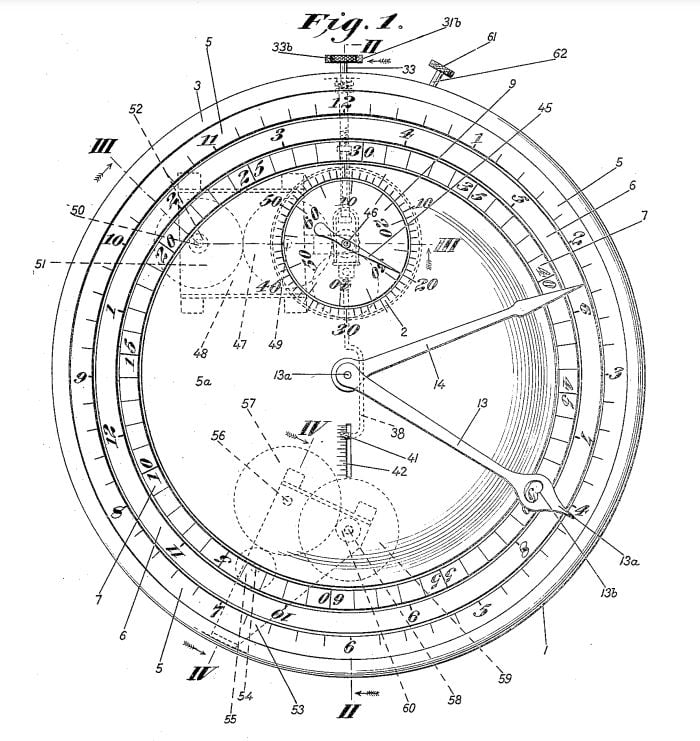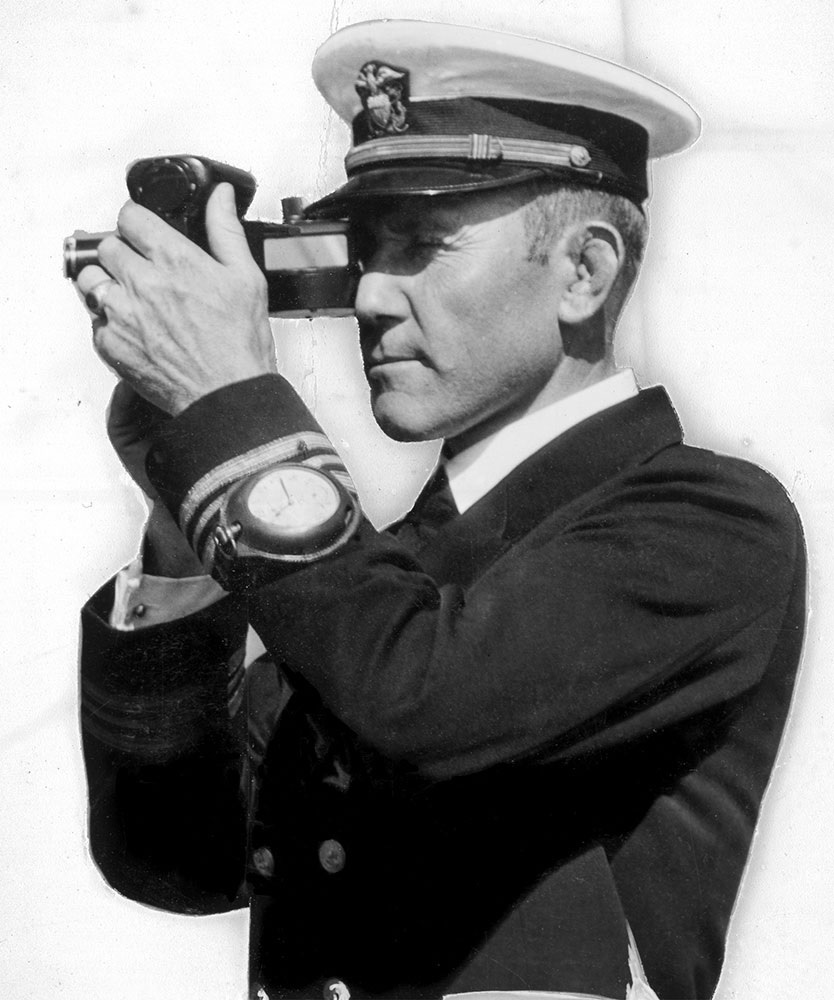DirtyDozen12
·Many people are likely familiar with Weems’ July 23, 1935 patent (US 2,008,734). In it, Weems famously described a time-keeping device that could be set to the second. This function allowed a pilot to synchronize his watch with a radio time signal. Weems’ invention was initially implemented by Longines in the form of a seconds dial that could be rotated to align the “60” second marking with the second hand, effectively setting the seconds of the watch. However, Weems’ patent was not limited to describing this invention. The patent contains a collection of inventions that pertain to time-keeping for the purposes of navigation. In my view, the most intriguing invention is one that has received little-to-no attention. I will attempt to provide a brief description of this invention, though I encourage anyone who is interested to read the patent itself.
Find the patent here: https://patentimages.storage.googleapis.com/88/cc/58/d7103769882020/US2008734.pdf
Here is a photo I took at the Longines Museum in Saint-Imier, in 2017.
In the patent, Weems described how navigation required keeping track of four different times: Greenwich civil time, Greenwich sidereal time, time by the true sun, and time by the mean sun. Conventionally, this was accomplished using four chronometers. Weems’ highlighted several drawbacks that were associated with the use of four chronometers in an aircraft, such as weight and cost. Weems’ invention aimed to address these drawbacks by consolidating multiple time-keeping devices. In order to accomplish this, Weems devised a timekeeper with a single display that could indicate two different times simultaneously. The primary time would be indicated by a typical hour hand, minute hand, second hand, and associated dial. The secondary time would be indicated using the same set of hands, and a set of rotating inner dials. These inner dials would rotate either clockwise or counter-clockwise in order to account for the difference in rate between the primary and secondary times. For example, suppose that the primary time was Greenwich civil time, and the secondary time was Greenwich sidereal time, which is approximately 3 minutes and 56 seconds faster per solar day. In this case, the secondary dials would rotate counter-clockwise in order to account for the shorter length of a sidereal day than a solar day. See Fig. 1 from the patent for an illustration of the two sets of dials.
Source: https://patentimages.storage.googleapis.com/88/cc/58/d7103769882020/US2008734.pdf
Now for the intriguing part, the way in which Weems thought to measure the primary and secondary times. For the primary time, a conventional chronometer movement would be used. For the secondary time, a non-chronometer movement would be used with little detriment to navigational accuracy. Initially, this may seem surprising since a non-chronometer movement might be expected to deviate by a few seconds per day, or even a few seconds per hour. To this point, Weems explained that a deviation of 36 seconds per hour would correspond to an error of 9 miles when attempting to determine one’s position. Crucially, this correspondence pertains to a movement that is directly indicating the time down to the second, and not a movement that is indicating the difference between two relatively close times. To understand this, consider that sidereal time is approximately 10 seconds per hour faster than solar time. Suppose that the primary time on Weems’ timekeeper was solar time, and the secondary time was sidereal time. This would mean that the rotating seconds dial would need to rotate counter-clockwise by 10 seconds per hour. This rate is equivalent to 60 degrees (360 degrees*10/60) per hour. Now, imagine how a deviation of 36 seconds per hour would affect the rotation of such a dial. A deviation of 36 seconds per hour is 1% (36 seconds/3600 seconds) or 0.6 degrees per hour. Since there are 6 degrees (360 degrees/60) between individual seconds markings on a dial, a deviation of 0.6 degrees is unlikely to translate to an incorrect indication of the seconds.
Upon reflection, Weems’ invention is relatively complicated. This may explain why it was not implemented, as far as I know. Further, I wonder if a single chronometer movement could simply power both the hands and rotating dials? Regardless, I found the concept rather ingenious.
Find the patent here: https://patentimages.storage.googleapis.com/88/cc/58/d7103769882020/US2008734.pdf
Here is a photo I took at the Longines Museum in Saint-Imier, in 2017.
In the patent, Weems described how navigation required keeping track of four different times: Greenwich civil time, Greenwich sidereal time, time by the true sun, and time by the mean sun. Conventionally, this was accomplished using four chronometers. Weems’ highlighted several drawbacks that were associated with the use of four chronometers in an aircraft, such as weight and cost. Weems’ invention aimed to address these drawbacks by consolidating multiple time-keeping devices. In order to accomplish this, Weems devised a timekeeper with a single display that could indicate two different times simultaneously. The primary time would be indicated by a typical hour hand, minute hand, second hand, and associated dial. The secondary time would be indicated using the same set of hands, and a set of rotating inner dials. These inner dials would rotate either clockwise or counter-clockwise in order to account for the difference in rate between the primary and secondary times. For example, suppose that the primary time was Greenwich civil time, and the secondary time was Greenwich sidereal time, which is approximately 3 minutes and 56 seconds faster per solar day. In this case, the secondary dials would rotate counter-clockwise in order to account for the shorter length of a sidereal day than a solar day. See Fig. 1 from the patent for an illustration of the two sets of dials.
Source: https://patentimages.storage.googleapis.com/88/cc/58/d7103769882020/US2008734.pdf
Now for the intriguing part, the way in which Weems thought to measure the primary and secondary times. For the primary time, a conventional chronometer movement would be used. For the secondary time, a non-chronometer movement would be used with little detriment to navigational accuracy. Initially, this may seem surprising since a non-chronometer movement might be expected to deviate by a few seconds per day, or even a few seconds per hour. To this point, Weems explained that a deviation of 36 seconds per hour would correspond to an error of 9 miles when attempting to determine one’s position. Crucially, this correspondence pertains to a movement that is directly indicating the time down to the second, and not a movement that is indicating the difference between two relatively close times. To understand this, consider that sidereal time is approximately 10 seconds per hour faster than solar time. Suppose that the primary time on Weems’ timekeeper was solar time, and the secondary time was sidereal time. This would mean that the rotating seconds dial would need to rotate counter-clockwise by 10 seconds per hour. This rate is equivalent to 60 degrees (360 degrees*10/60) per hour. Now, imagine how a deviation of 36 seconds per hour would affect the rotation of such a dial. A deviation of 36 seconds per hour is 1% (36 seconds/3600 seconds) or 0.6 degrees per hour. Since there are 6 degrees (360 degrees/60) between individual seconds markings on a dial, a deviation of 0.6 degrees is unlikely to translate to an incorrect indication of the seconds.
Upon reflection, Weems’ invention is relatively complicated. This may explain why it was not implemented, as far as I know. Further, I wonder if a single chronometer movement could simply power both the hands and rotating dials? Regardless, I found the concept rather ingenious.





